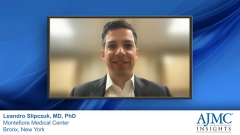
Treatment Disparities in the Management of ASCVD
Dr Slipczuk concludes our discussion by detailing healthcare disparities commonly seen within ASCVD treatment.
Episodes in this series

Leandro N. Slipczuk, MD, PhD: When we talk about health care disparities in ASCVD [atherosclerotic cardiovascular disease], that’s something we see here often. It’s something I’ve seen in my prior hospital in North Philadelphia [Pennsylvania] as well. Here in the Bronx [New York], we see it. But it happens in every city in United States. The first disparity that doesn’t involve ethnicity, race, or gender is knowledge. [We need to get] knowledge to patients and providers about the importance of identifying very high-risk patients and of reaching very low LDL [low-density lipoprotein]. Providers still get asked if it’s safe to reach a very low LDL. There are a lot of data that snow that it’s safe. So the first disparity is knowledge. In the modern area, there’s a lot of information on the internet. Institutions like AHA [American Heart Association] and ACC [American College of Cardiology] and journals…are trying to bring information to patients, providers, physicians, and nurse practitioners. That’s the first approach to this disparity.
The second one is having institutions in the safety net that they deal with patients who may not have the resources, to make sure there are ways around it. For example, we have a partnership with a company to approach patients with very high ASCVD risk. [It will] find someone who can guide patients into programs. There are so many programs. We have many programs in New York to assist people, but there are also programs from the pharmaceutical companies and from the NLA [National Lipid Association] to assist patients who don’t have the money to find the right therapy. Having that information and having someone who can guide the patient and show them is very important.
We’re learning more on this, and all the disparities have been tested; for example, for residual risk and understanding residual risk, such as lipoprotein. We know that this changes in different ethnicities, but it’s very important to have lipid clinics and metabolic clinics where this gets tested and to make sure we understand the receivable risk in our patients and how to manage.
This transcript has been edited for clarity.
Newsletter
Stay ahead of policy, cost, and value—subscribe to AJMC for expert insights at the intersection of clinical care and health economics.









































